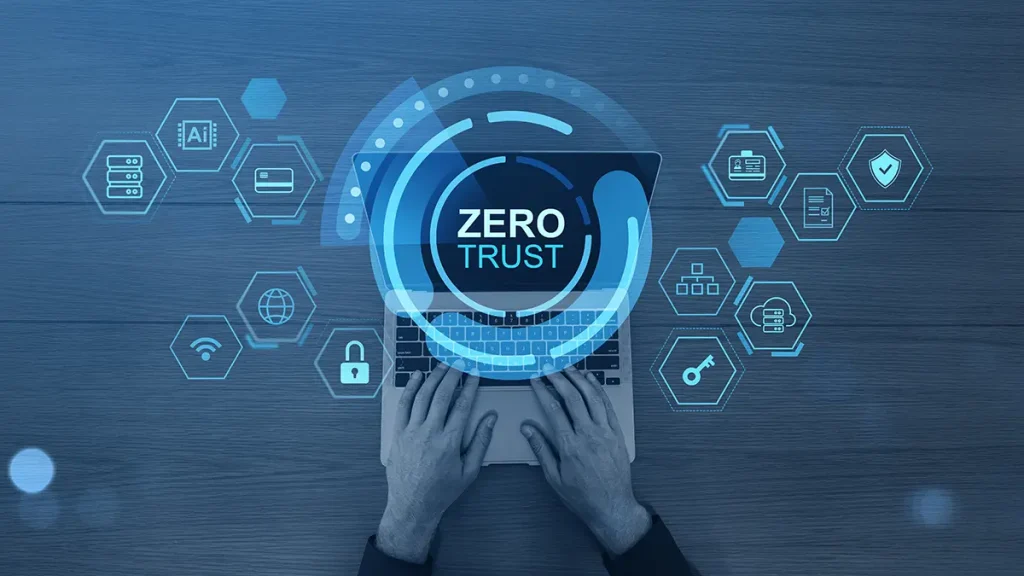In the ever-evolving world of cybersecurity, one truth has become clear trust is a vulnerability. For decades, organizations relied on traditional perimeter-based security models that assumed everything inside a network was safe. But in today’s digital landscape filled with remote workers, cloud platforms, and cyber threats that assumption no longer holds true.
Enter the Zero Trust Security model, a revolutionary framework that has redefined how we approach cybersecurity.
Table of Contents
What Is Zero Trust Security?
The Zero Trust model is based on a simple but powerful principle: “Never trust, always verify.”
Unlike traditional security systems that automatically trust users within a network perimeter, Zero Trust treats every user, device, and application as a potential threat — even those inside the organization.
According to the U.S. Cybersecurity and Infrastructure Security Agency (CISA), Zero Trust requires continuous verification of identity, strict access controls, and real-time monitoring of all network activities.
In short, every request for access must be authenticated, authorized, and encrypted no matter where it comes from.
Why Traditional Security Is No Longer Enough
In traditional IT systems, networks were like castles: strong walls (firewalls) on the outside and trusted access within. However, in the cloud era, that model fails because:
- Employees now work remotely from unsecured networks.
- Cloud applications and APIs extend data beyond local servers.
- Cybercriminals exploit stolen credentials and insider threats.
The 2024 Verizon Data Breach Report found that over 74% of breaches involved human error, credential theft, or misuse of trusted access. Clearly, perimeter security is no longer a match for today’s threats.
How Zero Trust Security Works
Zero Trust Security is not a single product it’s a strategic architecture that integrates identity management, access control, and continuous verification.
The framework typically includes:
1. Identity and Access Management (IAM)
Every user and device must prove its identity before accessing any resource. Multi-Factor Authentication (MFA), biometrics, and Single Sign-On (SSO) are key tools here.
Learn more from Microsoft Security.
2. Least Privilege Access
Users only get access to the exact data or system they need nothing more. This limits damage if credentials are compromised.
3. Microsegmentation
The network is divided into smaller segments to contain threats. Even if attackers breach one segment, they can’t move laterally across the system.
4. Continuous Monitoring
AI-driven analytics continuously monitor user behavior and detect anomalies in real-time. Tools from companies like CrowdStrike and Palo Alto Networks enable this level of active surveillance.
The Role of AI and Automation in Zero Trust Security
AI and automation are critical for scaling Zero Trust across large networks. AI systems detect unusual behavior such as logins from unfamiliar locations or devices and can automatically block or restrict access until verified.
The Forrester Zero Trust Framework describes how automation enables adaptive security, where policies change dynamically based on risk assessment.
Benefits of Adopting Zero Trust
- Stronger Data Protection: Sensitive information stays protected even if attackers breach the network.
- Reduced Insider Threats: Internal accounts are monitored just as closely as external access points.
- Cloud and Remote Security: Ideal for hybrid and remote work environments.
- Regulatory Compliance: Meets data security requirements from standards like GDPR, HIPAA, and ISO 27001.
Real-World Adoption of Zero Trust
Tech giants like Google and Microsoft were early adopters. Google’s internal framework, called BeyondCorp, eliminates VPNs and ensures employees can securely access company resources from anywhere.
Similarly, the U.S. Department of Defense has adopted a Zero Trust strategy to protect critical infrastructure and sensitive data. This shift underscores how essential the model has become to national and enterprise security alike.
Common Challenges in Implementing Zero Trust
Despite its benefits, Zero Trust is not without challenges:
- Complex Integration: Migrating legacy systems to Zero Trust can be time-consuming.
- Cultural Resistance: Employees often view continuous verification as inconvenient.
- Cost: Implementing Zero Trust requires investment in IAM, network segmentation, and AI monitoring tools.
However, experts from Gartner suggest that organizations adopting Zero Trust see a 45% reduction in security breaches on average.
Future of Zero Trust: Adaptive and Intelligent Security
As AI evolves, Zero Trust will become self-learning and predictive. Systems will automatically adjust security policies based on behavioral analytics and threat intelligence.
Future Zero Trust models will integrate machine learning, blockchain verification, and quantum-safe encryption to provide unmatched protection.
In other words, the Zero Trust of tomorrow won’t just verify it will anticipate.
Conclusion
The digital world has moved beyond fixed perimeters. With data flowing across clouds, devices, and continents, trust can no longer be assumed.
Zero Trust Security represents a cultural and technological shift toward continuous verification, minimal access, and constant vigilance. It’s not just a trend it’s the foundation of cybersecurity’s future.
As CISA emphasizes, adopting Zero Trust isn’t an option anymore it’s a necessity. In an era where one click can cause a global breach, “never trust, always verify” is the golden rule for survival.




1 thought on “Zero Trust Security – Comprehensive Guide – 2025”